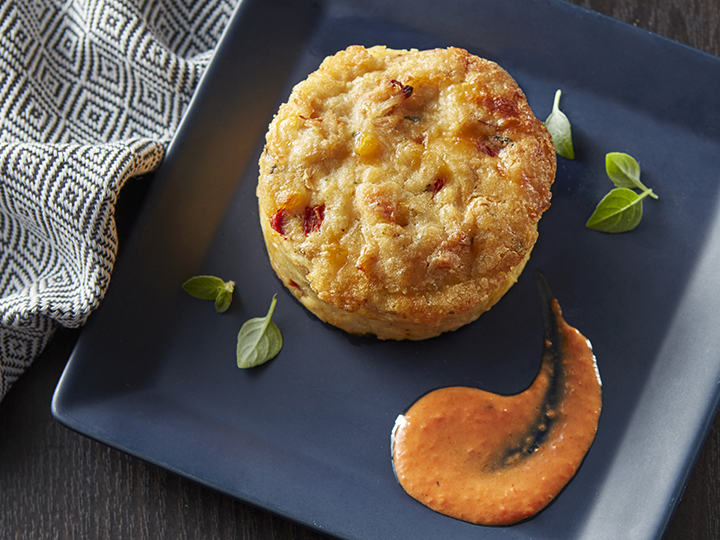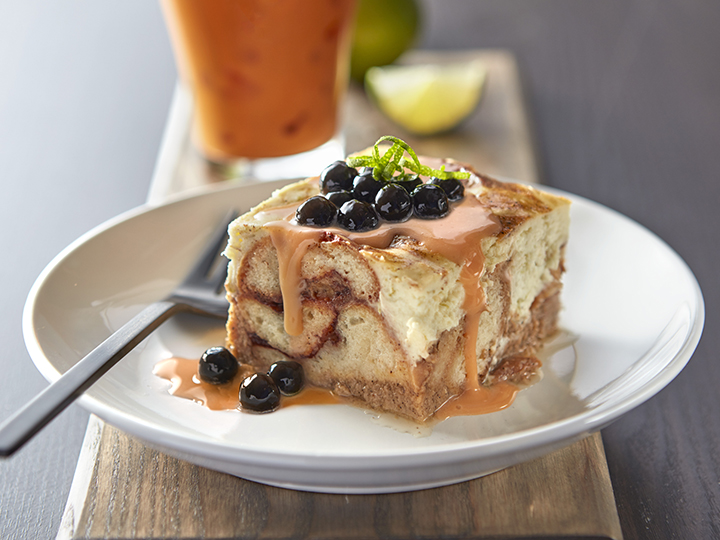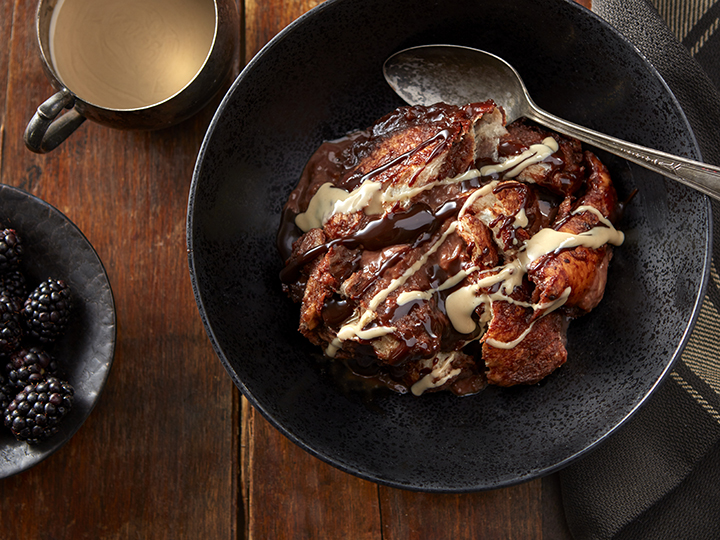The past several years have seen great strides from the food industry in embracing operational changes to reduce food waste–quantities of food, portion control at buffets, food donations, composting, and partnering with more local and sustainable farms. But there is another segment that sometimes goes under recognized in the role they play in protecting the planet: the chef.
“Most catering organizations are painfully aware of the food waste challenge, but most of the energies are focused on the operational side of the problem. I believe that at this point, it is almost too late,” says Los Angeles chef Alejandra Schrader. “How we prepare the food in the kitchen is such an important variable, so chefs have a big responsibility.”

Garlic cheddar biscuits and delicious crab unite for the ultimate flavor union, sure to delight your guests. Photo courtesy General Mills Convenience & Foodservice
That responsibility distills down to three components: precycling, upcycling, and recycling.
“I do believe that chefs are stewards of the earth,” says Schrader. “We are caretakers, and we are in a unique position to care for the planet.”
So, what can you do in your own kitchens?
Precycling
Precycling. It’s the relationships you cultivate with your produce vendors, or distilleries and breweries in your town.
“We invest so much, so many resources, so many people’s time, and so much money growing food, cooking it, and serving it,” said Dana Gunders with ReFED, during an early summer 2021 webinar on reducing food waste. “But when we throw food out, all that goes to waste.”
ReFED is a national nonprofit working to end food loss and waste across the U.S. food system.
Pay attention to your purchasing
One of the biggest causes of food waste is over-purchasing. While catering companies tend to be wise about sourcing ingredients for their most popular dishes, there may be a tendency to overbuy for dishes that aren’t so common in the kitchen.
“You have to be aware of what you’re ordering, what’s being served, and what’s ending up in the trash,” Gunders said. “You have to start paying attention to what your customers are telling you they don’t want, or what they don’t value as these plates come back to the kitchen.”
Maximize your ingredients
You can cut down on your waste, as well as the amount of food you must purchase, by exploring how a single ingredient can translate into myriad dishes.
For example, a simple carrot can transition into every course of a meal with a few creative innovations:
- Hors d’oeuvres. Creamy Carrot Soup Shooter: a decadent and rich appetizer that embodies the creamy goodness of carrot soup in a single serving shot glass.
- Side. Carrot Chips: roasting thinly sliced carrots in olive oil elevates them from a fairly standard veggie into a truly delicious side.
- Main. Carrot Hot Dog: a great option for your vegan guests, made with carrots marinated in vinegar and spices.
- Dessert. Carrot Cake: a deliciously moist cake with cream cheese frosting, ginger, cinnamon and nuts.
The beauty of imperfect produce
You can be a home for when a farmer has an abundance of lumpy, slightly overripe or bruised tomatoes. He must get rid of them; they’re trash to him but to you, you can process them into a sauce or jam. Grab them for gazpacho or panzanella. Maybe there are peppers that are bruised or have spots from a freeze.
“You have to have compassion for these vegetables because you’re still getting fresh and glorious produce,” culinary nutritionist Lisa Dorfman says. “They were simply dropped from heaven with a twist.”
Upcycling
Another way that chefs are innovating their kitchens is by experimenting with upcycling, which essentially translates to utilizing the whole plant.
“I have been motivated to discover creative uses for food and ingredients that usually end up in the trash bin. From peels and seeds to stems, stalks and leaves, I use as much of each plant as possible, and the result has been new flavors with nutritious benefits,” Schrader says. “Chefs are naturally curious and creative, so once they set their mind to cooking with the whole ingredient, they will discover new uses for things that were formerly thrown away, and at the same time, they will enhance the flavor and nutritional value of their creations.”

Leftover cinnamon rolls with a Thai tea-inspired custard and lime cheesecake swirl. Photo courtesy General Mills Convenience & Foodservice
When cooking with the whole plant, however, it’s important to be aware that one of the biggest challenges is texture. Many of the parts of the plant are very hard or fibrous, which can often lead to the flavor being locked inside. However, when these parts are added to a blender or food processor such as a Vitamix, you can “discover the potential,” Schrader said.
“Chefs are drawn to the challenge of using the whole plant (from root to leaf) or animal (from nose to tail) once they truly grasp the positive impact they can have on the richness and flavor of the food,” she adds.
Upcycling isn’t just reserved for produce either. For example, ground up mussel shells can be used to add flavor to pasta dishes, and stale bread can be repurposed for such dishes as bread puddings, soufflés, and French toast.
“It’s a way to reinvigorate the stale items,” says Jessie Kordosky, chef with General Mills Convenience & Foodservice. “As chefs, we’re all about using products that can work harder for our menus. And since moisture is lost as the baked goods stale, it’s a nice vessel to soak up custard (and other liquids).”
Consider what Chef Keith Lord with Stratəjē Fourteen was able to do: He combined “ugly avocados” with roasted onions and tops, whey from feta, and charred carrot tops and fennel stocks to create “the best dressing ever.”
“We’re saving the world one avocado at a time,” he said.
Recycling
The third pillar when reducing food waste in the kitchen is recycling anything remaining.
One way to recycle, which will also have future benefits, is to create a ‘virtuous cycle,” similar to that of Tredwells out of London. A farmer will collect the restaurant’s food waste for use as mulch, which in turn goes to helping grow fresh produce for the restaurant.
“You can regrow lettuce, regrow ginger,” says Kathleen Stoehr, Director of Community & Content Strategy for Informa Connect. “Set up a small area and save some money on your produce purchases by sticking one of those romaine heads back into the dirt after you chop the leaves off. Why not?”
A similar solution is to recycle your unused produce to provide feed for livestock.

Leftover croissants can be repurposed for a bread pudding recipe. Photo courtesy General Mills Convenience & Foodservice
An emerging solution for recycling unused food waste is insect farming. According to ReFED, when insects are mass produced under controlled conditions, they can break down significant quantities of degraded food waste. As insects consume food waste, they produce multiple valuable commodities, such as insect biomass, pharmaceuticals, biofuels, lubricants, and fertilizer from their excrement. Many insect species can also be used as human food or feed for animals. They have the potential to improve food supply and provide a source of protein that is more energy-efficient and has a lower environmental impact.
And who can forget the importance of re-distributing surplus food by partnering with community sharing and food bank programs.
Advocacy through education
Implementing a process of precycling, upcycling, and recycling can seem like a lot to take on, and it is, which is why it’s small incremental changes that will make all the difference. And fortunately, there are countless resources available to help us move forward.
ReFED for example, has identified a Roadmap to 2030, which looks at the entire food supply chain and identifies seven key action areas showing where the food system must focus its efforts in order to reduce food waste by 50%. The seven action areas are: Optimize the Harvest; Enhance Product Distribution; Refine Product Management; Maximize Product Utilization; Reshape Consumer Environments; Strengthen Food Rescue; and Recycle Anything Remaining.
Another great resource is the Chef’s Manifesto from SDG2 Advocacy Hub, which outlines a list of eight highly actionable items that food makers can do immediately to build a more sustainable food supply for generations to come. The Chef’s Manifesto was cultivated from input by more than 100 chefs from 36 countries. One of the eight areas of the Chef’s Manifesto is Value Natural Resources and Reduce Waste.
“We need to think about the choices we make,” Schrader says. “Even small changes—like the balance in our diet between meat and plants or even how we shop and store our food—can make a substantial difference in our ecological footprint.”
Farm to kitchen to table
By paying attention to what they’re ordering, and what’s going unused, not only will chefs be contributing to the health of the earth, but they will also be improving their bottom lines.
“When you throw away food, you’re quite literally putting money in the garbage,” said Chef Jennifer Hill Booker, with Your Resident Gourmet out of Atlanta, during the ReFED webinar. “There's such a slim margin of revenue that if you’re throwing away your revenue and your profit, your business will eventually fold.”
As we continue to navigate the climate crisis through the lens of the food industry, it’s imperative that we look at it from multiple perspectives–from farm to kitchen to table.
“We can decide—or influence—what farming practices we are supporting. We can prepare foods in ways that utilize every part of every ingredient, minimizing waste as much as possible. And we can show others through the food we serve that they can try to emulate our approach at home,” Schrader said. “Chefs are leaders. They are in the vanguard. What we do, others will do, too. We have the power to change diets and the ways people think about food.”
Check back tomorrow for a trio of recipes from chef Alejandra Schrader for Recipe Friday that utilize upcycled ingredients.



